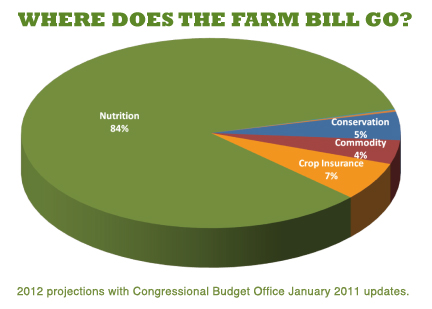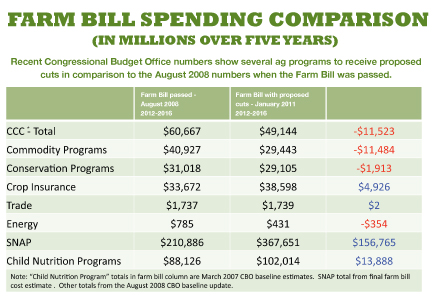Although the Farm Bill isn’t set to expire until late 2012, a rash of recent budget cut proposals have brought the bill to the public forefront as policymakers debate the Farm Bill’s future.
“The Farm Bill is important for everyone,” says Tim Gerlach, Executive Director of the Minnesota Corn Growers Association. “This is a national program that’s good for the entire nation.”
While its wide-ranging programs affect virtually all Americans, public perception of the Farm Bill may be a far cry from the reality.
“People hear ‘Farm Bill’ and equate it to funding for farmers,” says Brad Lubben, Assistant Extension Professor and Policy Specialist at the University of Nebraska. “The reality is that the bill is an important federal policy that impacts everyone in America.”
The 673-page Farm Bill consists of 15 titles covering programs such as Nutrition (including the Supplemental Nutrition Assistance Program), Forestry (including USDA Forest Service programs), Energy (including bioenergy and renewable energy), Livestock (including meat and poultry inspections), Rural Development, and Disaster Assistance.
The bill provides money for everything from food banks to healthy-snack programs for schoolkids to land conservation programs.
“Whether you know it or not, you’re affected by the Farm Bill,” says Lubben.
‘Farm’ small part of Farm Bill
For such a wide-ranging bill, though, many misconceptions still persist.
“The term ‘Farm Bill’ itself is a misnomer,” says Lubben. “Currently, 75 to 80 percent of the Farm Bill is actually in the nutrition section, with the majority of that coming from the Supplemental Nutrition Assistance Program (Food Stamps). By any stretch, the farm side of the Farm Bill has become a relatively small part of the bill’s budget.”
Despite comprising a fraction of the total bill, many of the farm-specific programs, especially renewable fuels, offer the highest economic upside. Yet it’s these programs that are targeted for the highest percentage of those proposed cuts.
“There is a lot of discussion about programs that many people don’t know much about, especially advanced biofuels,” says Pat Westhoff, Director of the Food and Agricultural Policy Research Institute at the University of Missouri. “You just have to hope they don’t undercut the folks who are working to make these fuels for the future at such a critical time for the biofuel industry.”
When it comes to the ethanol industry, for example, many believe that these short-term savings from ag cuts would come at the expense of an industry poised to positively impact the country, not only economically but also when it comes to the environment and national security.
“The public and the policymakers need to understand how critically important these biofuel programs are,” says Ernie Shea, Project Coordinator with the 25×25 Alliance, a group focused on the goal of producing 25 percent of the country’s energy from renewable fuels by 2025. “We have an industry that’s trying to compete against a legacy energy system like the petroleum industry, which is heavily subsidized. When you compare them, the relative amount of money that goes to biofuel subsidies versus fossil fuel subsidies is minute yet important, and we shouldn’t be cutting them off. Biofuels are a pathway to a new energy future, a cleaner energy future, and certainly one that’s more secure and less costly.”
According to the most recent Congressional Budget Office numbers, the proposed cost of many farm programs have actually come in lower than projected when the current Farm Bill passed in 2008.
“There’s a legitimate argument that the ag portion of the Farm Bill saves taxpayer money. That said, it will be difficult to balance the competing interests while trying to get the federal deficit under control. understanding the economic fundamentals behind these ag programs is paramount to making sound policy decisions,” says Rob Skjonsberg, Senior Vice President of Public Policy and Corporate Affairs for POET.
“The economic reality is that American farmers are providing more efficiencies at a better return to the taxpayer than what they’re getting credit for,” says Skjonsberg. “The actual cost of farm programs is
less than one-half of one percent of
the entire federal budget. If cuts are going to be made – we hope the congress works towards parity and doesn’t single out specific industries.”
Actual spending
Those “economic fundamentals” would probably surprise all but the most ardent Farm Bill followers. While it’s called the Farm Bill, the actual ag aspects of the bill – mainly commodity programs, crop insurance, and conservation programs – make up less than one-fifth of the five-year omnibus.
By far the largest portion is dominated by nutrition programs, primarily SNAP or more commonly known as Food Stamps. For the 2012 fiscal year, nutrition spending is projected to comprise 84 percent of the bill’s baseline spending. The so-called “ag subsidies” section is projected to make up just 16 percent of the Farm Bill.
“If you look at current spending, and you broadly define ‘ag subsidies’ as that safety net of commodity programs and crop insurance programs and disaster assistance programs, that whole package is about a $15 billion annual safety net,” says Lubben. “The total Farm Bill is now in the neighborhood of $120 billion to $140 billion per year, and the size of that total bill changes daily, because you’ve got entitlement programs like SNAP that are based on eligibility. With the recent economy, we’ve seen the rise in SNAP spending drive up the total Farm Bill.”
Early projections for the 2012-2016 Farm Bill, in fact, show a cut to the total farm programs, with an estimated $169 billion increase in nutrition programs, including a $156 billion increase over five years for SNAP.
“Many of those ag programs maintain a very important safety net for America’s farmers,” says Gerlach. “Although times might be good right now for certain commodities, that can be a very different picture averaged over time. This bill gives them something they can count on when they stick their necks out financially at the whim of mother nature and the markets.”
Billions less
When it comes to the actual spending for farm programs, though, investments in new technology have directly led to better cost efficiencies. The ethanol industry, for example, has helped reduce support subsidies to farmers by creating a demand for corn and driving rates higher than production costs. Due to these higher prices for agricultural commodities, direct support payments from the Farm Bill were approximately $7 billion less than expected in 2010.
“The economic reality is that American farmers are providing more efficiencies at a better return to the taxpayer than what they’re getting credit for,” says Skjonsberg. “The actual cost of farm programs is less than one-half of one percent of the entire federal budget.”
Misguided cut
For POET, budget cuts threaten projects that, after years of research and investment, are exceptionally close to becoming the type of economic realities that could reduce dependence on foreign oil and create homegrown jobs.
“Ethanol is the only viable option that we have right now to lessen our dependence on foreign oil,” says Rep. Collin Peterson (D-Minn.), a ranking member of the House Agriculture Committee. “Eliminating or cutting funding for renewable energy research and programs will move us backward, not forward. The programs put in place through the Farm Bill are necessary to give certainty to those in the industry. The ethanol market has revived rural communities and provided a competitive market for farmers. A strong ethanol industry is essential to advancing the next generation of renewable fuels from the farm.”
For example, Project LIBERTY, POET’s cellulosic plant in Emmetsburg, Iowa, is slated to open in 2012 with the world’s first commercial-scale production of cellulosic ethanol – a projected 25 million gallons per year from corn cobs.
By 2022, POET plans to be responsible for 3.5 billion gallons of cellulosic ethanol annually as part of a national program designed to reduce greenhouse gases, reduce petroleum imports, and develop and expand the renewable fuels industry.
If those long-term projections come to fruition, those 3.5 billion gallons of cellulosic ethanol would translate directly into jobs and agricultural income. The Department Of Energy estimates that for every 1 billion gallons of ethanol production, 10,000 to 20,000 new jobs will be created. Recently, the Environmental Protection Agency projected that, by 2022, crops grown for biofuels would increase farm income by $13 billion.
“These types of projects are investments in the future,” says Shea. “These are important investments in economic recovery, environmental improvements, clean air, clean water, and national security. It’s not just a Farm Bill, it’s a bill with worthwhile projects that will affect our country’s future – everyone’s future.”
Gerlach, of the Minnesota Farm Growers Association, agrees. “The Farm Bill represents America’s farmers and America’s food and America’s future.”








